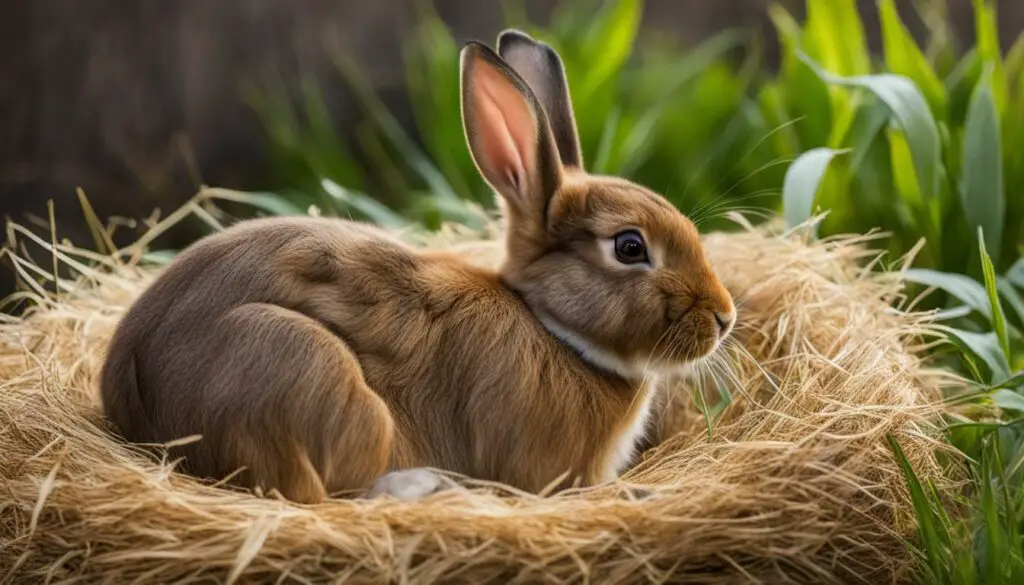Welcoming a pregnant rabbit into your home can be an exciting and rewarding experience. But to ensure the well-being of your furry friend and her upcoming litter, it’s important to understand the ins and outs of rabbit pregnancy, breeding, and care. In this comprehensive guide, I will provide you with the knowledge and advice you need to navigate the journey of your pregnant rabbit.
Key Takeaways:
- Pregnant rabbits can conceive every two weeks once sexually mature
- The gestation period for rabbits is around one month
- Female rabbits can become fertile within 24 hours after delivering their litter
- Early signs of pregnancy in rabbits include increased appetite and weight gain
- Creating a suitable environment with a separate nest box is crucial for a stress-free pregnancy
Detecting Pregnancy in Rabbits
During early pregnancy, it can be challenging to determine if a rabbit is pregnant. However, experienced rabbit owners may notice certain signs and behaviors that can indicate pregnancy. Some of the common signs of pregnancy in rabbits include increased appetite and weight gain. A pregnant doe may also exhibit nesting behaviors, such as gathering materials to build a nest. Additionally, you may observe changes in the doe’s behavior, such as being more protective or territorial.
One method to detect pregnancy in rabbits is by palpating the doe’s abdomen. Around 12 days into the pregnancy, you can gently feel the doe’s abdomen to check for the presence of developing fetuses. It is important to handle the doe carefully and seek guidance from a veterinarian or experienced breeder if you are unsure. However, it is important to note that palpation should be done by a professional to avoid causing harm to the unborn kits or the mother.
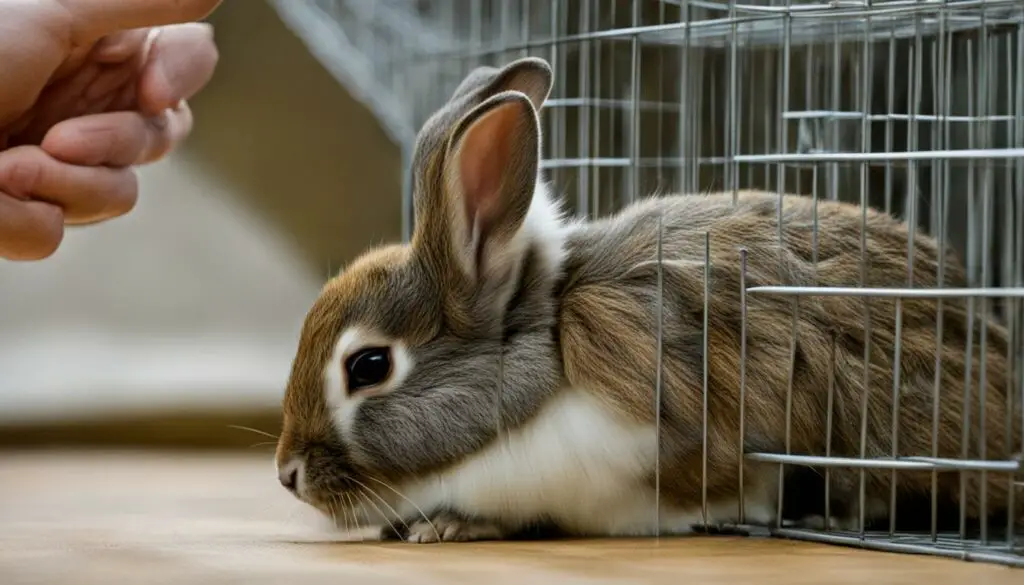
If you suspect your rabbit may be pregnant, it is advisable to consult with a veterinarian for confirmation and proper guidance. They can perform more accurate diagnostic tests, such as ultrasound or X-rays, to determine if the doe is indeed pregnant and estimate the number of kits she may be carrying. Remember, proper prenatal care is crucial for the well-being of the pregnant rabbit and her offspring.
Creating a Suitable Environment for a Pregnant Rabbit
When caring for a pregnant bunny, it is crucial to provide a suitable environment that promotes her well-being and ensures a stress-free pregnancy. One of the first steps is to separate the pregnant doe from other rabbits. This separation prevents potential aggression towards the kits and allows the doe to have a quiet and peaceful space of her own.
To give the pregnant rabbit a sense of security and encourage natural nesting behavior, it is important to provide a nest box. The nest box should be large enough for the doe to comfortably move around and build a nest for her upcoming litter. Fill the nest box with soft bedding material, such as hay or shredded paper, to create a cozy and warm environment for the kits.
Additionally, the pregnant doe should be housed in a quiet area with minimal disturbances. Loud noises and excessive handling can cause stress for the rabbit, which can negatively impact her during pregnancy. Creating a calm and serene setting will help the doe feel safe and allow her to focus on caring for her developing kits.
Table: Checklist for Creating a Suitable Environment for a Pregnant Rabbit
| Step | Details |
|---|---|
| Separate from other rabbits | Prevent aggression and provide a stress-free space |
| Provide a nest box | Allow the doe to build a nest and create a comfortable space |
| Use soft bedding material | Hay or shredded paper can provide warmth and coziness |
| Ensure a quiet environment | Reduce noise and disturbances to minimize stress |
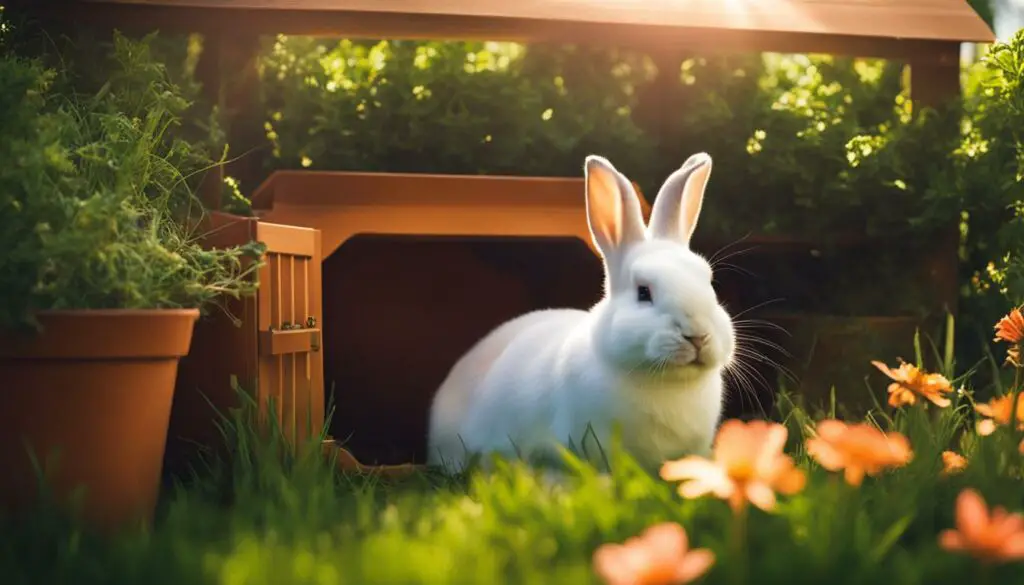
By following these guidelines and providing a suitable environment for a pregnant rabbit, you can ensure the well-being of both the doe and her future kits. Remember, a happy and stress-free doe will result in healthier and happier babies.
Understanding Doe Behavior with Newborn Kits
When it comes to understanding rabbit reproduction, it is essential to familiarize ourselves with doe behavior after giving birth to newborn kits. Female rabbits, also known as does, exhibit distinct behaviors during this crucial period. Let’s take a closer look at the fascinating world of doe behavior with their newborn kits.
The Nursing Schedule
After giving birth, does will nurse their kits once or twice a day, usually during the early morning hours and again at dusk. This nursing schedule provides kits with the necessary nutrients while allowing the doe to spend long stretches of time away from her young. It is important to note that the doe’s absence from the nest does not indicate neglect or abandonment; it is a natural behavior that helps protect the kits from predators.
Minimal Handling
During the early stages of kit development, it is recommended to minimize handling to avoid causing unnecessary stress to both the doe and her young. The kits are born hairless, blind, and deaf, relying heavily on their mother for warmth, nourishment, and care. By limiting human interaction with the kits, we can ensure their well-being and foster a healthy bond between the doe and her offspring.
To help visualize the timeline of doe behavior with newborn kits, let’s take a look at the following table:
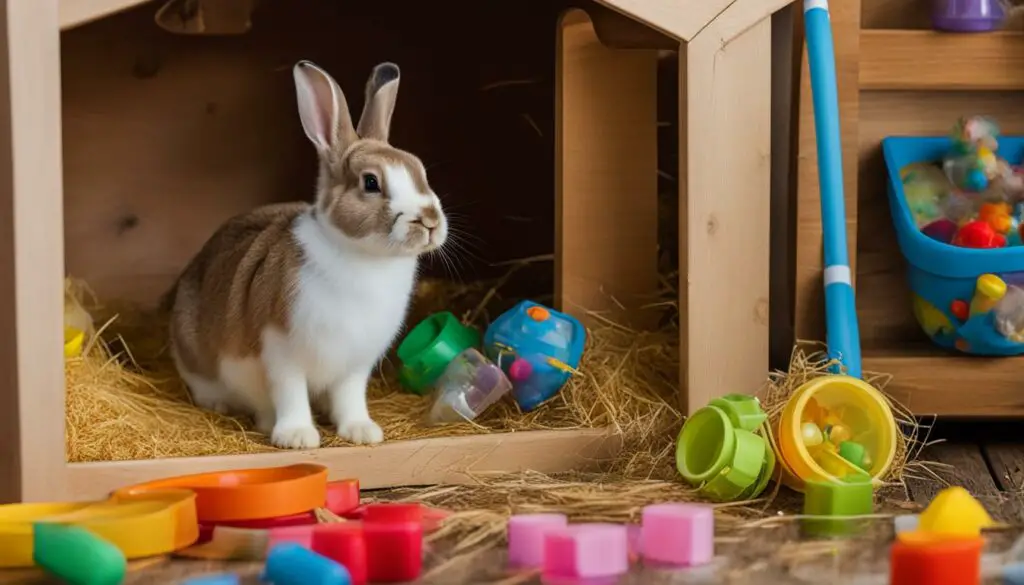
As shown in the table, the kits will begin exploring their surroundings at around two weeks of age. This milestone marks the start of their journey towards independence. It is essential to provide a safe and secure environment for the kits to explore while ensuring their separation from unneutered bucks to prevent unwanted mating.
In conclusion, understanding doe behavior with newborn kits is crucial for providing appropriate care during this delicate period. By respecting the doe’s nursing schedule, minimizing handling, and creating a safe environment for the kits to grow, we can ensure the health and well-being of both the doe and her young.
Nutrition for a Pregnant or Lactating Doe
Feeding a pregnant or lactating rabbit is crucial for her health and the well-being of her offspring. During this stage, the doe’s nutritional needs increase to support the growth and development of the kits. It is important to provide a balanced diet that meets the specific requirements of a pregnant or lactating rabbit.
Table: Recommended Diet for a Pregnant or Lactating Doe
| Food | Quantity |
|---|---|
| Timothy hay | Unlimited |
| Fresh vegetables (leafy greens, carrots, bell peppers) | About 1 cup per 5 pounds of body weight |
| Pellets | About 1/4 cup per 5 pounds of body weight |
| High-quality hay-based rabbit feed | As directed by the manufacturer |
| Water | Always available |
In addition to a diet rich in hay and fresh vegetables, the pregnant or lactating doe may benefit from a higher intake of high-quality rabbit pellets. These pellets provide essential nutrients such as protein and fiber to support the growth of the kits. It is important to follow the manufacturer’s guidelines for pellet feeding based on the doe’s body weight.
During lactation, a doe may experience increased thirst and therefore, access to fresh, clean water should be provided at all times. Dehydration can affect milk production and the overall health of the doe and her kits. Ensure that the water source is easily accessible and changed regularly to maintain cleanliness.
When Rabbits Can Mate and Reproduce
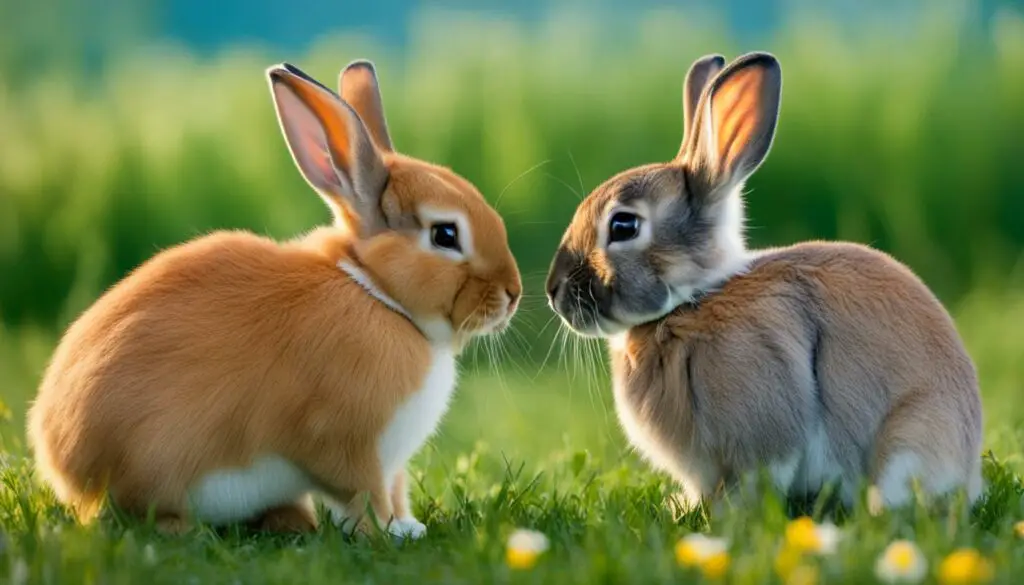
Understanding the maturity and breeding age of rabbits is essential for responsible rabbit ownership. Female rabbits, also known as does, can become pregnant as early as 12 weeks old. It is important to note that earlier pregnancies can pose health risks for young does, and it is generally recommended to wait until they are at least 6 months old before breeding them. On the other hand, male rabbits, or bucks, can also start mating at around 12 weeks old.
While rabbits may reach sexual maturity at a young age, it is essential to consider multiple factors before allowing them to mate. Breeding rabbits too early can lead to health complications for the doe and her offspring. Therefore, it is crucial to consult with a veterinarian or an experienced rabbit breeder to determine the appropriate age for breeding based on the doe’s overall health and development.
It’s worth mentioning that rabbits can continue to reproduce until they are around 4 years old. However, it is important to practice responsible breeding to avoid overcrowding and ensure the wellbeing of the rabbits. Additionally, rabbits can conceive at any time of the year, so it is crucial to separate unneutered bucks and does to prevent unwanted pregnancies.
Table: Rabbit Maturity and Breeding Age
| Rabbit | Maturity Age | Recommended Breeding Age |
|---|---|---|
| Female (Doe) | 12 weeks | 6 months or older |
| Male (Buck) | 12 weeks | 6 months or older |
| Maximum Reproductive Age | Around 4 years old | |
Ensuring the health, safety, and responsible breeding of rabbits are key considerations for any rabbit owner. By understanding the maturity and breeding age of rabbits, we can make informed decisions to promote the wellbeing of these furry companions.
Preparing for the Arrival of Newborn Kits
As the due date approaches, it’s important to ensure that the mother rabbit, or doe, is provided with everything she needs for a stress-free birthing experience. Here are some essential steps to prepare for the arrival of newborn kits:
Giving the Doe Proper Nutrition
During pregnancy, the mother rabbit needs a well-balanced diet to support the growth of her kits. Provide her with plenty of clean water and high-quality rabbit pellets specifically formulated for pregnant and nursing does. Additionally, offer fresh hay and a variety of fresh vegetables to ensure she gets all the necessary nutrients. A healthy and nutritious diet will contribute to the overall health of the doe and her kits.
Creating a Suitable Nesting Area
Rabbits instinctively build nests to provide a safe and warm environment for their kits. To encourage nest building behavior, provide the doe with a suitable nest box filled with soft hay or straw. Place the nest box in a quiet and secluded area of the enclosure to give the doe privacy. This will help her feel secure and ensure the safety of the newborn kits.
Monitoring the Doe’s Behavior
As the due date approaches, keep a close eye on the doe’s behavior. She may become more restless and spend more time in the nesting box. She may also pluck fur from her belly to line the nest, another instinctive behavior to provide warmth for the kits. These signs indicate that the doe is preparing for the birth of her kits, and it’s important to provide her with a calm and comfortable environment during this time.
| Preparation Steps | Details |
|---|---|
| Proper Nutrition | Provide a balanced diet with rabbit pellets, fresh hay, and vegetables. |
| Creating a Nesting Area | Provide a suitable nest box with soft hay or straw for the doe to build a nest. |
| Monitoring Behavior | Observe the doe for signs of restlessness and nesting behavior. |
By taking these steps to prepare for the arrival of newborn kits, you can help ensure a smooth and successful birthing experience for both the doe and her kits. Remember to provide the doe with plenty of care and attention during this special time.
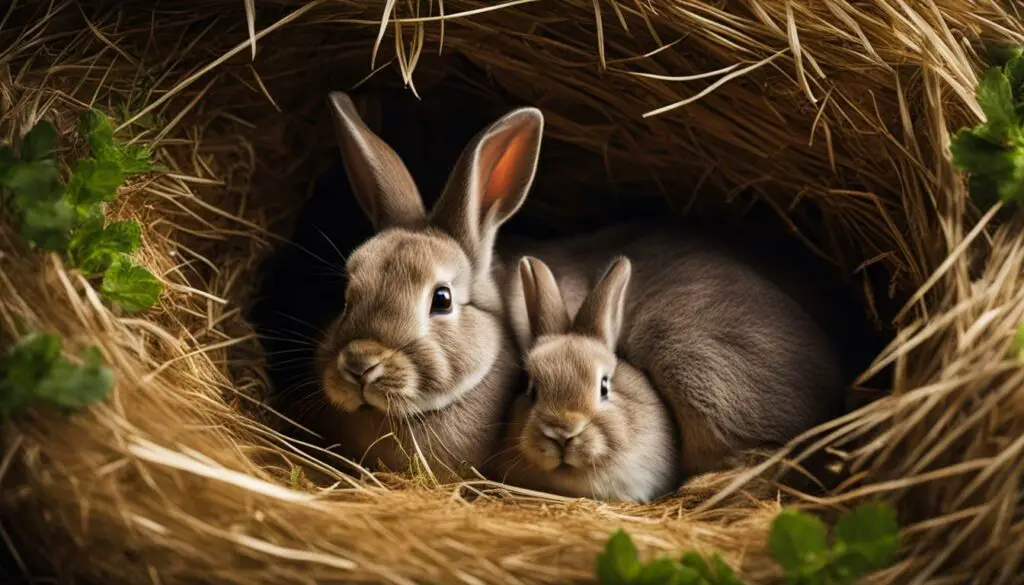
Caring for Rabbit Litters
When it comes to caring for baby rabbits, or kits, there are a few essential factors to keep in mind. As newborns, kits are born hairless, blind, and deaf, relying entirely on their mother for nourishment and warmth. The average litter size is around six kits, although it can range up to 14. It is important to provide a safe, comfortable, and nurturing environment to ensure the healthy development of the kits.
One crucial aspect of caring for rabbit litters is ensuring that the doe, or mother rabbit, is properly nursing her kits. Does typically nurse their kits twice a day at dawn and dusk. During this time, it is essential to give the doe privacy and space to bond with her kits. Minimizing handling and disturbances during this period will help reduce stress for both the doe and the kits.
As the kits grow, they will begin to explore their surroundings at around two weeks of age. It is important to provide a safe and secure enclosure to prevent any accidents or escapes. Gradually introduce solid food, such as hay and pellets, to the kits’ diet starting at around three weeks of age. By four to six weeks, the kits should be fully weaned and ready to transition to a solid food diet.
| Key Points |
|---|
| Baby rabbits, or kits, are born hairless, blind, and deaf. |
| The average litter size is around six kits. |
| The doe will nurse her kits twice a day at dawn and dusk. |
| Kits should be gradually introduced to solid food starting at around three weeks of age. |
Caring for rabbit litters requires attentive observation and understanding of the natural behaviors of the doe and the kits. Providing a safe and nurturing environment, ensuring proper nursing, and introducing solid food at the appropriate time are all essential aspects of raising healthy and happy baby rabbits. Patience, diligence, and a warm-hearted approach will contribute to the successful care of rabbit litters.
Providing Space for the Doe and Kits
When caring for a pregnant rabbit and her kits, it is important to provide a suitable enclosure that allows for adequate space and separation. Creating a separate area within the doe’s enclosure ensures that she has a quiet and secure space away from the kits, as it is instinctive for the doe to protect them from potential predators.
The separate area can be created using a small, enclosed space within the enclosure, such as a hutch or a designated corner that is sectioned off. This area should have enough room for the doe to move around comfortably and stretch out, but also provide a sense of privacy and security for her and the kits. It should be cozy and well-ventilated to maintain a comfortable temperature.
By providing a separate space for the doe, you allow her the opportunity to rest and recharge, as well as reduce the risk of her accidentally injuring or smothering the kits. This also helps to prevent the kits from venturing too far away or getting lost within the larger enclosure. It is important to regularly monitor the doe and kits to ensure their safety and well-being.
| Key Points | Details |
|---|---|
| Enclosure Size | Ensure the doe’s enclosure is large enough to accommodate a separate space for her and the kits. |
| Privacy and Security | Create a cozy and secure area within the enclosure to provide a safe and comfortable space for the doe and kits. |
| Regular Monitoring | Regularly check on the doe and kits to ensure their safety and well-being within the enclosure. |
Providing a dedicated space for the doe and kits within the enclosure is crucial for their safety and well-being. It allows the doe to have her own space to rest and care for her kits without the risk of interference or accidents. By considering the size, privacy, and regular monitoring, you can ensure a comfortable and secure environment for your pregnant rabbit and her kits.
Rehoming the Kits
Rehoming baby rabbits is an important step in their development and well-being. As the kits reach approximately 8 weeks of age, they are ready to transition to their new homes. Finding suitable and responsible owners is crucial to ensure the rabbits are provided with proper care and a nurturing environment.
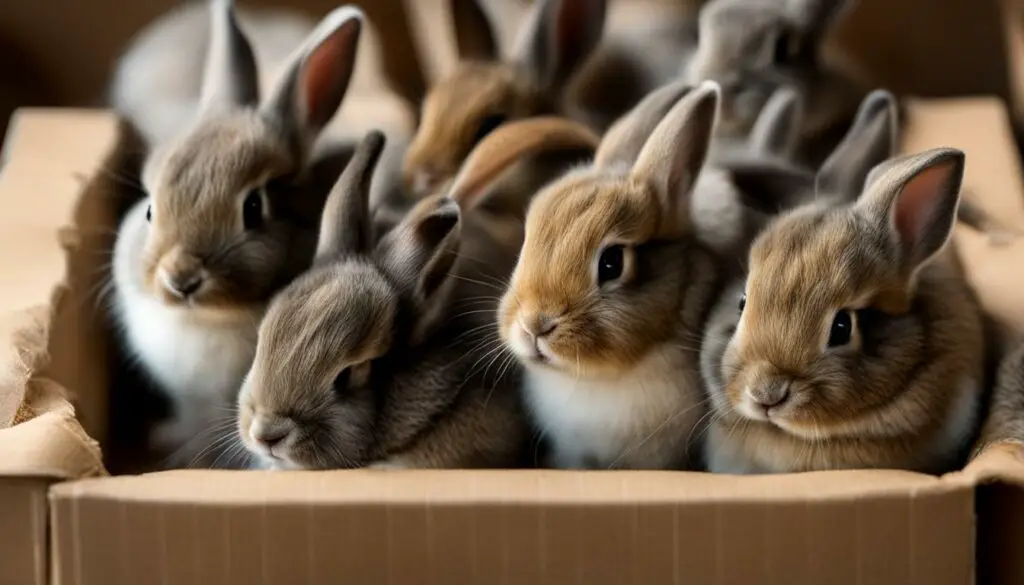
When looking for potential adopters, it is essential to consider their experience and knowledge of rabbit care. They should be aware of the specific needs of a rabbit, including appropriate housing, nutrition, and socialization. Responsible owners should also be committed to providing a lifetime of care for their new rabbit.
One way to ensure proper rehoming is by conducting a thorough screening process. This can involve asking potential adopters a series of questions to gauge their understanding of rabbit care and their commitment to providing a loving and suitable environment. It is also helpful to provide informational resources and guidance to new rabbit owners to support them in their journey.
Table: Questions for Potential Adopters
| Question | Response |
|---|---|
| Do you have previous experience with rabbits? | |
| What type of housing will you provide for the rabbit? | |
| What is your understanding of a rabbit’s dietary needs? | |
| How do you plan to socialize the rabbit? | |
| Are you prepared for the long-term commitment of caring for a rabbit? |
Proper rehoming not only ensures the well-being of the kits but also helps prevent unplanned rabbit pregnancies. Neutering is highly recommended to avoid future breeding and reduce the population of rabbits in rescue centers. By educating potential adopters about the benefits and importance of neutering, we can help reduce the number of rabbits in need of homes.
Remember, finding suitable homes and responsible owners for the kits is a crucial part of their journey. By taking the time to thoroughly assess potential adopters and providing ongoing support, we can ensure that these baby rabbits are given the best chance at a happy and healthy life.
Dealing with False Pregnancies in Rabbits
False pregnancies in rabbits can sometimes occur, leading to confusion for rabbit owners. It is important to be aware of the signs of false pregnancy in rabbits to avoid unnecessary worries. While false pregnancies can exhibit similar behaviors to real pregnancies, a veterinarian can confirm whether or not a doe is truly pregnant.
Signs of false pregnancy in rabbits may include nesting behavior, weight gain, and changes in appetite. The doe may also exhibit protective behavior towards her nest, even if there are no kits present. It is important to note that false pregnancies can happen even if the doe has not been mated.
“False pregnancies in rabbits can be a result of hormonal fluctuations. It is important to consult with a veterinarian to rule out any medical conditions,” states Dr. Jane Thompson, a renowned veterinarian specializing in small animals.
If you suspect that your rabbit is experiencing a false pregnancy, it is recommended to seek advice from a veterinarian. They can perform a thorough examination and provide the necessary guidance. Remember, it is always better to err on the side of caution and ensure the well-being of your rabbit.
Table: Signs of False Pregnancy in Rabbits
| Signs | Description |
|---|---|
| Nesting Behavior | The doe may build a nest and collect materials, similar to preparing for a real pregnancy. |
| Weight Gain | The doe may appear to gain weight, similar to a pregnant rabbit. |
| Changes in Appetite | The doe’s appetite may increase or decrease, similar to a pregnant rabbit. |
| Protective Behavior | The doe may exhibit protective behavior towards her nest, even without the presence of kits. |
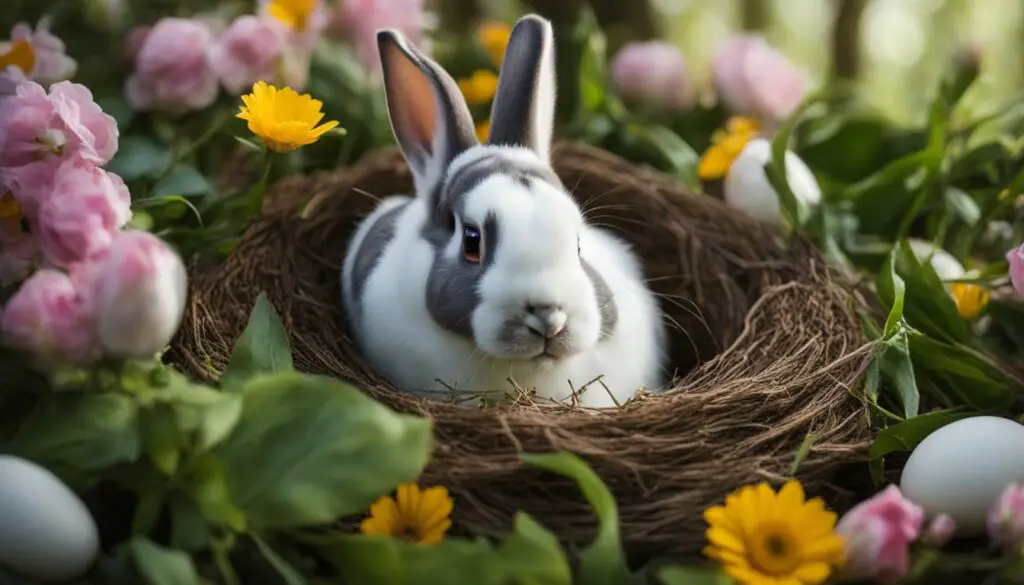
In conclusion, false pregnancies in rabbits can occur and mimic real pregnancies in terms of behavior and physical changes. If you suspect that your doe is experiencing a false pregnancy, it is important to consult with a veterinarian for proper diagnosis and guidance. Remember, the well-being of your rabbit is the utmost priority.
Neutering as a Solution
Neutering is a recommended practice to prevent unwanted rabbit pregnancies and to promote responsible pet ownership. By spaying female rabbits or castrating male rabbits, we can effectively prevent continuous breeding and reduce the number of rabbits that end up in rescue centers.
Neutering not only helps prevent the challenges and responsibilities associated with unplanned litters but also offers numerous health benefits for rabbits. Spaying female rabbits can eliminate the risk of uterine cancer, pyometra, and mammary tumors, while castrating male rabbits can reduce the risk of testicular cancer and prevent aggressive behavior.
When it comes to preventing rabbit pregnancy, neutering offers a long-term solution that allows for the keeping of compatible male-female pairs without the constant risk of breeding. Neutered rabbits can live harmoniously together without the need for constant supervision or the worry of unplanned litters. Additionally, neutering can help improve overall rabbit behavior and reduce territorial tendencies.
The Benefits of Neutering:
- Prevents unwanted pregnancies and reduces the number of rabbits in shelters
- Eliminates the risk of reproductive-related health issues
- Promotes compatibility between male-female pairs without continuous breeding
- Improves overall rabbit behavior and reduces aggression
Neutering is a common and routine procedure performed by skilled veterinarians. It is generally recommended to neuter rabbits between 4 and 6 months of age, although the exact timing may vary depending on the rabbit’s breed and overall health. It is best to consult with a veterinarian experienced in rabbit care for personalized advice and guidance.
By choosing to neuter our rabbits, we can contribute to the responsible pet ownership and help ensure the welfare of these beloved animals. Neutering not only prevents unwanted pregnancies but also promotes a healthier and happier life for our furry companions.
Remember, the decision to neuter a rabbit should always be made in consultation with a qualified veterinarian who can provide the best advice for your specific situation.
Conclusion
Understanding the care needs of a pregnant rabbit is crucial for their well-being and the successful raising of their kits. Providing a suitable environment, proper nutrition, and understanding their behaviors are key factors in ensuring a healthy and stress-free pregnancy.
During pregnancy, it’s important to separate the pregnant doe from other rabbits to prevent aggression towards the kits and to create a stress-free environment. Providing a nest box for the doe encourages natural nesting behavior, helping her feel safe and secure.
Ensuring the doe has access to clean water and a nutritious diet throughout pregnancy is essential. Slowly introducing any dietary changes over a period of 5-10 days is recommended to prevent digestive issues. Additionally, increasing the doe’s food intake after giving birth supports her lactation and the growth of healthy kits.
Neutering is highly recommended to prevent unwanted pregnancies and to allow for the keeping of compatible rabbit pairs. By neutering rabbits, we can help reduce the number of rabbits that end up in overcrowded rescue centers and promote responsible pet ownership.
FAQ
How can I tell if my rabbit is pregnant?
Early pregnancy in rabbits can be difficult to detect, but experienced rabbit owners may notice behavioral changes such as increased appetite and weight gain. Around 12 days into the pregnancy, the fetuses can be felt when palpating the doe’s abdomen. Weight gain is most apparent towards the end of gestation.
How long is the gestation period for rabbits?
The gestation period for rabbits is typically around one month, lasting between 31 and 33 days.
How many kits can a rabbit have in a litter?
Rabbit litters can range in size from 2 to 12 kits, with the average litter size being around 6 kits. However, it is not uncommon for a litter to have up to 14 kits.
How often do female rabbits nurse their kits?
Female rabbits, or does, usually nurse their kits once or twice a day, typically overnight.
When can baby rabbits leave their mother?
Baby rabbits, or kits, can leave their mother at around 8 weeks old.
Should I separate the pregnant doe from other rabbits?
Yes, it is important to separate pregnant does from other rabbits to prevent aggression towards the kits and to ensure a stress-free environment.
How can I create a suitable environment for a pregnant rabbit?
Providing a nest box for the doe encourages nest building behavior. It is important to give her privacy and a quiet and safe environment.
How long does it take for kits to be weaned?
Kits are usually fully weaned between 4 to 6 weeks of age.
When can rabbits start reproducing?
Female rabbits can become reproductively mature at around 12 weeks old and can continue to have kits until around 4 years of age.
What should I feed a pregnant rabbit?
The doe’s diet should remain the same throughout breeding and pregnancy, but it is important to feed according to her body condition to prevent rapid growth of the kits. Increasing the doe’s food intake after giving birth is recommended. Slowly introduce any changes in the diet over a period of 5-10 days.
Can rabbits have false pregnancies?
Yes, rabbits can experience false pregnancies, which can exhibit similar behaviors to real pregnancies. A veterinarian can confirm whether or not a doe is truly pregnant to avoid false alarms.
Why is neutering recommended for rabbits?
Neutering is recommended to prevent unwanted pregnancies and to allow for the keeping of male-female pairs without the risk of continuous breeding. Neutering can help reduce the number of rabbits that end up in rescue centers.

